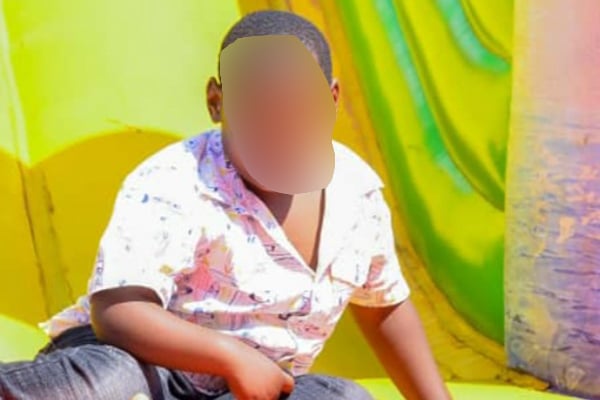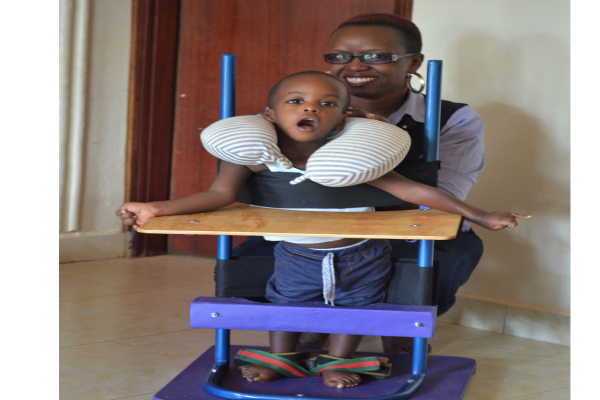Prime
Ahereza’s journey with cerebral palsy

By the end of his first term in school, Ahereza’s speech improved. PHOTO | COURTESY
What you need to know:
- At two months of age, Simon Ahereza was diagnosed with celebral Palsy. Although the disease limits him in a number of ways, with his mother’s determination and help from others, he has been able to hit a number of milestones.
On October 22, 2014, Jenninah Atukunda went for her last antenatal appointment. The birth of her second child was three weeks away and she could not wait for him to arrive. But the doctor seemed uneasy before announcing that the fluid (amniotic fluid) around the baby in the uterus had reduced.
Amniotic fluid protects the baby from being bumped or hurt during pregnancy. It also keeps the baby at a healthy temperature.
Atukunda was then advised to go for an emergency scan before she was retained for admission. Later in the evening, Simon Ahereza was delivered, weighing just about 1.8 kilogrammes.
‘‘After a day, I went to visit him in the nursery and was agonised by how small and fragile he was. I could not bring myself to hold him,’’ Atukunda, an administrator, says.
But a few days later, she would compose herself to carry him. The day they were discharged, a nasogastric (NG) tube was fixed through Ahereza’s nose for feeding with a goal of having his body weight reach at least two kilogrames.
‘‘That first week was the most challenging for us. One day, we drove to the hospital thrice to have the NG tube re-fixed. This was because he had become active, often moving his hands and in the process removing it,’’ she says, adding that thankfully, by the end of the first week he had gained the required weight and the feeding tube was removed.
Noticeable changes
As Ahereza continued to grow, his mother noticed that his hands were always fisted but she took it lightly since he was a baby. But nine months later, she started getting concerned since he was not achieving his milestones such as sitting down and crawling, among others.
‘‘All he would do was lie in his bed quietly all day. I then sought an opinion from a doctor (especially on his fisted hand) who advised me to take him to Mulago National Referral Hospital,’’ she says, adding that they consulted a paediatrician who requested for a scan.
A few days later, they were told he had Cerebral Palsy which could have been caused by lack of oxygen to the left part of his brain thus affecting motor movements in his right hand and leg.
Congenital disorder
Cerebral palsy is a congenital disorder of movement, muscle tone or posture brought about due to abnormal brain development, often before birth. Symptoms include developmental delays where a child is slow to reach milestones such as rolling over, sitting, crawling, and walking. Others are stiff or floppy muscles as well as abnormal postures.
It is the most common cause of childhood physical disability globally and is more prevalent in low-income and middle-income countries. Eight out of 100 children suffer from cerebral palsy, especially in rural Uganda. There is lower prevalence in the older (eight-17 years) than younger (two-seven years) age groups, according to findings of a Lancet study conducted in 2015.
Treatment
Long-term treatment for these impairments that can range from mild to severe requiring assistance with all activities, includes physical and other therapies, according to Edwin Mwebaze, a physiotherapist. ‘‘Sometimes, surgery is required,” he adds.
Interventions to prevent malaria infections such as the use of insecticide-treated mosquito nets, coupled with caregiver training and support, including best feeding practices and simple measures to prevent other infections, could potentially reduce mortality in children with cerebral palsy in this region,” the Lancet study states.
‘‘There I was with a child that faced a possibility of never walking and I switched on the denial mode,’’ Atukunda says.
The doctors then advised them to go to the physiotherapy unit where they would be given more assistance.
‘‘A week later, I took Ahereza and his elder brother to the physiotherapy unit where we met a gentleman who made our situation worse. He asked several questions about him but what ticked me off was the comparison between Ahereza’s head and that of his brother. I broke down and started crying. I was broken because of the way this man analysed Ahereza. All I could see was him painting a picture of a ‘vegetative state’,’’ she says.
That was the moment she resolved not to let people define her child and promised to do everything possible to fight for him. She later went to LifeLink Hospital in Namugongo, Kampala, and during the therapy session, she was given Dr Emmanuel Odhiambo, a physiotherapist’s contact details. Six months to Ahereza’s second birthday, Dr Odhiambo started walking Ahereza’s journey with them.
Journey to walking
The experience taught Atukunda to believe in her instincts and not to be afraid to walk away, especially when she had doubts.
‘‘When we met Dr Odhiambo in 2016, he assessed Ahereza and encouraged us to be patient and do our part because with such sickness it would take a lot of time to get results,’’ she says.
‘‘We worked out a private arrangement where he came home three days a week to train us on the different exercises. As a family, we were blessed to have a maid (Joan) who did a tremendous amount of work with Ahereza. She was a fast learner and faithfully exercised him three days a week,’’ she adds.
The doctor’s schedule then became twice a month, mostly to assess him. These exercises were too intense and painful for Ahereza that Atukunda could not stand seeing him cry. Such interventions were too costly that at one time Atukunda asked Dr Odhiambo, with whom they had worked together for almost a year, to take back the standing frame so she could get something else to help condition his legs to bear the weight of his body.
At 21 months, Ahereza started crawling on his bottom, a major milestone for the entire family. Three months later, he was able to walk with help and eventually on his own thanks to Joan’s commitment.
‘‘There is also a couple that stood with us on this journey and faithfully contributed towards our medical bills on a monthly basis,” Atukunda says.
Starting school
Atukunda was able to enrol Ahereza in school aged three. At this stage, he could only use his left hand to do everything but the right one was fisted and stiff. His speech too was minimal and he could just say a few words such as ‘cup’, ‘go’, ‘come’.
‘‘I wanted him to enroll in our normal education system and see how he catches up with his agemates. I remember explaining his condition as I sought his admission and how the teacher was at first reluctant to have him begin school. She advised that we wait for the next year,’’ she adds.
‘‘I managed to convince her otherwise since I was aware that he could understand his surroundings and respond positively and how important it was for him to be with other children. All I wanted was a chance for him to learn from his age mates.’’
Ahereza was so excited to begin school, and within a week, he was popular in his stream. He is friendly, confident and has an irresistible smile. He is also intelligent. By the end of his first term in school, Ahereza’s speech had greatly improved.
The school management also let them continue with the physiotherapy sessions at school, even opening up their music room for him to use. These sessions were often held as his classmates took the mid afternoon nap.
Tools
During this journey, their physiotherapist recommended that they include play-doh in Ahereza’s routine play.
This is a modelling compound made out of edible products and is an important aide, especially in early childhood development.
It can be used to promote concentration in children as they get busy squishing the clay making different models. High level of concentration is achieved overtime.
Hand-eye coordination is enhanced as the child plays, and strengthening of hand muscles is enhanced as the child squishes and squashes the play clay.
Challenges
The challenge while at school would be getting the right people to help with the therapy sessions. One gentleman gave up after two months because he did not see any progress.
‘‘This was fine by me because he did not know our story and the journey we had accomplished,’’ she says.
Also, the daily exercises would exhaust him yet this was necessary. These were limited to three times a week.
‘‘Over time I had to learn the types of exercises needed and by the first lockdown due to Covid-19, it was easier.
Now, aged seven, Ahereza and his mother exercise together at home. She also encourages him to take the lead.




